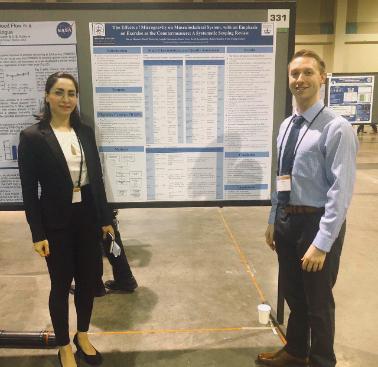Recently Completed Projects
Physical Activity and the Child-Parent Experience – A Workshop on Creative Movement for Young Children and Caregivers

On November 7, 2019, Marion Bakhoya (doctoral student) and Anamaria Amador (masters student) in the Applied Physiology program presented their work at the American College of Sports Medicine New England Chapter annual meeting in Providence, Road Island. This year’s meeting was titled, “Enhancing Health and Human Performance: Science to Practice.” Paul Gallo, an Alum of Teachers College Applied Physiology Program was the chair of the program committee that organized this dynamic conference.

The title of Marion and Anamaria’s workshop was, “Physical Activity and the Child-Parent Experience – A Workshop on Creative Movement for Young Children and Caregivers.” Opportunities for very young children to be physically active require involvement from parents or caregivers. Their work has found physical activity participation in parent child dyads is particularly effective in improving physical activity in young children from disadvantaged communities. In this workshop Marion and Anamaria introduced and provided opportunities for attendees to practice techniques that help to engage both children and caregivers in creative movement dance based activities. Attendees were also proved with tools to learn basic methods for working in bilingual/multilingual communities. This dance based workshop introduced a fun and exciting opportunity to engage children and caregivers in evidence based physical activity.
RELATIONSHIP BETWEEN MUSCLE DEOXYGENATION AND WORKLOAD AT PEAK EXERCISE IN HEALTHY ADULTS USING NEAR-INFRARED SPECTROSCOPY
Ashley M. Goodwin1,2, Jacqueline Montes2, Ipek Ensari3, Feliz Marie Hernandez2, Kayla Coutts2, Ashwini K. Rao2, Carol Ewing Garber FACSM1
1Teachers College, Columbia University, New York, NY 2Department of Rehabilitation and Regenerative Medicine, Program in Physical Therapy, Columbia University Irving Medical Center, New York, NY 3Columbia University Data Science Institute, New York, NY
BACKGROUND: Near-infrared spectroscopy (NIRS) is used to investigate muscle oxygenation, but the association of muscle deoxygenation (deoxygenated hemoglobin, deoxy[Hb+Mb]; ΔHHb) to workload during exercise needs further study. PURPOSE: To characterize the relationship between the change in muscle deoxygenation (ΔHHb) and maximal workload (MW) achieved during maximal cardiopulmonary exercise test (CPET).
[this abstract has been accepted to present in a thematic poster session at ACSM 2019]
The Effects of Microgravity on The Musculoskeletal System of Humans and Animals, with an Emphasis on Exercise as a Countermeasure: A Systematic Scoping Review

Darya Moosavi, David Wolovsky, Angela Depompeie, David Uher, David Lennington, & Roddy Bodden, Carol Ewing Garber.
Exposure to weightlessness that occurs in long-duration space missions have negative effects on the musculoskeletal system, causing muscle and bone atrophy. Exercise has been recommended as the most effective countermeasure to prevent loss of bone and muscle mass in the extreme conditions. However, the most effective form of exercise for prevention of loss of bone and muscle mass in microgravity environment, in terms of type, intensity, duration and frequency is unknown.
The purpose of this study is to comprehensively review and summarize the literature regarding the effect of microgravity on musculoskeletal system, including measures of bone mineral density, bone strength, bone stiffness, muscle mass, muscle strength, and transformation of muscle fibers types, in humans and animals. The second aim of this study is to investigate the effectiveness of exercise countermeasure on musculoskeletal system under microgravity and space radiation condition, in humans and animals.
[this manuscript is under review; it was presented as a poster presentation at the 2020 NASA Human Research program in Galveston, TX]
HIGH INTENSITY INTERVAL TRAINING IS ASSOCIATED WITH DECREASED NEGATIVE AFFECT IN INDIVIDUALS WITH ANXIETY DISORDERS
Vincenzo Lauriola1
1Teachers College, Columbia University
Background: Anxiety disorders are associated with elevations in negative affect (NA) in addition to anxiety, including depression and stress, as well as reduced quality of life. High intensity exercise has been shown to reduce NA in this population but no studies have yet explored the effects of a high intensity interval training (HIIT) protocol administered in patients’ homes with weekly remote coaching. Purpose: To investigate associations between 2 heart rate (HR)-derived indices of exercise volume and change scores on NA measures using a novel high intensity interval training (HIIT) protocol administered at home with remote coaching in people with anxiety disorders.
REVIEW OF SIX MINUTE WALK TEST NORMATIVE REFERENCE VALUES FOR USE IN SPINAL MUSCULAR ATROPHY
Ashley M. Goodwin1,4, Kayla M.D. Cornett2, Marnee J. McKay3, Joshua Burns3, Carol Ewing Garber4, Darryl C. De Vivo2, Jacqueline Montes1,2
1Department of Rehabilitation and Regenerative Medicine, Program in Physical Therapy, Columbia University Irving Medical Center, New York, NY, 2Department of Neurology, Columbia University Irving Medical Center, New York, NY, 3The University of Sydney & The Children’s Hospital at Westmead, Sydney, New South Wales, Australia, 4Teachers College, Columbia University, New York, NY.
PURPOSE:To critically review published normative data describing the six-minute walk test (6MWT) performance by healthy individuals and to select reference equations to compare with 6MWT performance by patients with Spinal Muscular Atrophy (SMA).
[this manuscript is under review; it was presented as a podium presentation at Cure SMA 2018]
FACTORS ASSOCIATED WITH OBJECTIVELY MEASURED EXERCISE PARTICIPATION AFTER HOSPITILIZATION FOR ACUTE CORONARY SYNDROME
Ashley M. Goodwin1,2, Andrea T. Duran1,2, Ian M. Kronish2, Nathalie Moise2, Gabriel J. Sanchez2, Carol Ewing Garber1, Joseph E. Schwartz2,3, Keith M. Diaz2
1Teachers College, Columbia University,New York, NY, 2Center for Behavioral Cardiovascular Health, Columbia University Medical Center, New York, NY, 3Department of Psychiatry and Behavioral Science, Stony Brook University, Stony Brook, NY
BACKGROUND: Guidelines recommend exercise for secondary prevention of acute coronary syndrome (ACS), however adherence to guidelines is low. A paucity of data examining factors associated with objectively-measured exercise post-discharge in ACS survivors exists. PURPOSE: to identify factors associated with exercise during the 5 weeks after ACS discharge.
Comparison of two brief physical activity questionnaires with accelerometry in a multi-ethnic group of adults
Completed in cooperation with Dr. Norberto Quiles of Queens College, the principal investigator on this study.
Key Information: The purpose of this study is to determine the accuracy of two short physical activity questionnaires in healthy adults. We are doing this because measuring physical activity in an accurate way is important given the relationship between being physically active and good health. The study will last a total of 7 days and will require participants to wear a physical activity monitor at the hip for the duration of the study. Height and weight will also be measured, and information regarding income and education will be gathered, along with information about daily physical activity using 2 short questionnaires.
ATTENUATED RESPONSE OF MUSCLE DEOXYGENATION AT HIGHER WORKLOADS, DETERMINED BY NEAR-INFRARED SPECTROSCOPY
Ashley M. Goodwin 1-2 , Jacqueline Montes 2 , Ipek Ensari 3, Ashwini K. Rao 2 , Carol Ewing Garber FACSM 1
1-Department of Biobehavioral Sciences, Teachers College, Columbia University, New York, NY
2-Department of Rehabilitation and Regenerative Medicine, Programs in Physical Therapy, Columbia University Irving Medical Center, New York, NY
3-Columbia University Data Science Institute, New York, NY
ABSTRACT
BACKGROUND: The relationship of muscle deoxygenation to maximum workload at peak exercise using near-infrared spectroscopy (NIRS) can provide insight into clinical populations with known exercise intolerance, but there are few studies available. PURPOSE: To characterize the relationship between change in muscle deoxygenation (deoxygenated hemoglobin; ΔHHb) and maximal workload achieved at peak exercise (MW). METHODS: 15 males and 3 females (mean+SD: 27.28±13.60 years [age]) underwent a cardiopulmonary exercise test (CPET) on a recumbent cycle ergometer. Measurements at peak exercise included ΔHHb of the left vastus lateralis using NIRS, MW (Watts), and oxygen uptake (VO2peak). We regressed ΔHHb on MW at peak exercise as the primary predictor with VO2peak as a covariate. We used a second order polynomial regression model to test for both linear and quadratic relationships. RESULTS: Participant characteristics (mean+SD) were as follows: ΔHHb =12.67+7.30 μmol, MW = 241.22+61.82 W, and VO2peak = 40.71+9.29 mL/kg/min. A polynomial model including ΔHHb, MW and VO2peak best characterized the relationship (F= 3.654, p= 0.05) where there appears to be an inflection point in the ΔHHb-MW relationship (see Figure 1). Each 30 W increase in workload was associated with 0.74 increase in ΔHHb up to 241 W, after which ΔHHb decreased curvilinearly (-0.172) with each further increase in 30 W. CONCLUSION: ΔHHb increases with incremental workload but appears to attenuate and slightly decrease at greater MW. It is possible that other factors may influence this relationship. Understanding how muscle deoxygenation, MW, and VO2peak are related at the time of peak exercise, or if other factors are contributing the differences in ΔHHb at higher workloads, may provide a foundation for uncovering the physiological mechanisms of local oxygen uptake in low and high exercise capacity individuals, and to assess exercise-limiting factors in clinical populations.
Supported by NIH Grant K01HD084690-01A1.
The Effects of Classroom-Based FUNdamental Integrative Training (FIT) on Muscular Strength, Endurance, and Power in School-Aged Children: A Pilot Study.
Department of Biobehavioral Sciences, Teachers College, Columbia University, New York, NY
The Relationship Between Physical Activity, Body Composition, Isokinetic Strength and inflammatory markers in Covid-19 survivors.
1- Department of Biobehavioral Sciences, Teachers College, Columbia University, New York, NY
2- Department of Exercise Physiology, Shahid Beheshti University, Tehran, Iran
In the present coronavirus disease (COVID-19) pandemic, millions of people world-wide are being restricted to little social activity and stay-at-home orders. This means that the level of daily physical activity will be reduced considerably and very quickly compared to habitual life. Physical inactivity has been classified as a public health problem. (Physical Activity Guidelines for Americans, 2018) The excess fat with muscle loss along with the age-related decline of physical and functional capacity has been associated with increased risk of disability, morbidity and development of several chronic diseases (Global Recommendation on Physical Activity for Health, 2010). For these reasons, it’s important to describe the patterns and pervasiveness of sedentary behavior in Covid-19 survivors during the hospitalization and period following hospitalization, as well as determine whether these patterns are linked to musculoskeletal strength. Currently, no studies have examined the amount of time Covid-19 survivors engage in sedentary behaviors after hospitalization, a critical time period when lifestyle interventions ideally begin. Therefore, the purpose of this study is to investigate the relationship between prolonged physical inactivity, knee and ankle muscle strength, and body composition in Covid-19 survivors.